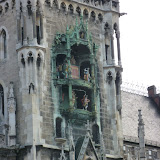 |
| München |
Today we headed to Munich, or München in German, to spend the morning. We arrived in time to see the huge glockenspiel on the Rathaus chime. The Rathaus-glockenspiel gives its performance three times a day during the summer, at 11am, noon and 5pm. After watching it chime Shelby and I headed up to the top of St. Peter's Church for a better view of the city. Only 306 stairs up a narrow, creaking, wooden staircase and you get a fabulous view of the Rathaus and surrounding city. After that we stopped for some lunch. I went to a backerei (bakery) and got an egg and cheese sandwich on a sunflower seed roll, and Shelby went to a metzgerei (butcher) and got a bratwurst and a dried salami. After lunch it was time for us to get on the road and head to Dachau, just outside of Munich, to visit a concentration camp.
 |
| Dachau Concentration Camp |
Dachau Concentration Camp was the very first concentration camp to open in Germany and was a model for others within the country. Over 200,000 prisoners walked through the gates which read, Arbeit macht frei, or work makes free. Though there are almost 32,000 recorded deaths at the camp, it is unknown exactly how many prisoners died or were killed here because those numbers do not include prisoners sent to Dachau for "special treatment" or those sent from Dachau to another camp to be killed. Just entering the grounds gives an eerie feeling and seeing how massive the camp was is overwhelming. We Listened to stories from survivors of the camp tell how inhumanely they were treated. How the guards determined your life at camp the moment you arrived and how your fate was constantly up in the air depending on the moods of the Nazi guards.
Conditions were grossly overcrowded. One interesting thing about the camp is that due to the high use of the existing crematorium, a second larger crematorium with gas chamber was built on the grounds. The gas chamber was disguised to look like a bath house for disinfecting prisoners, equipped with fake drains and shower heads to make it look real. It is not known why the gas chamber was never used, only that is was not for reasons of mercy on behalf of the Nazi officials. Unfortunately, the crematoriums were used often.
Shelby and I would like to go back another time when we can leave Colin with a babysitter. Children are not allowed in any of the museum buildings so we took turns going into the main buildings, but missed a lot of the history and exhibits this time.




No comments:
Post a Comment